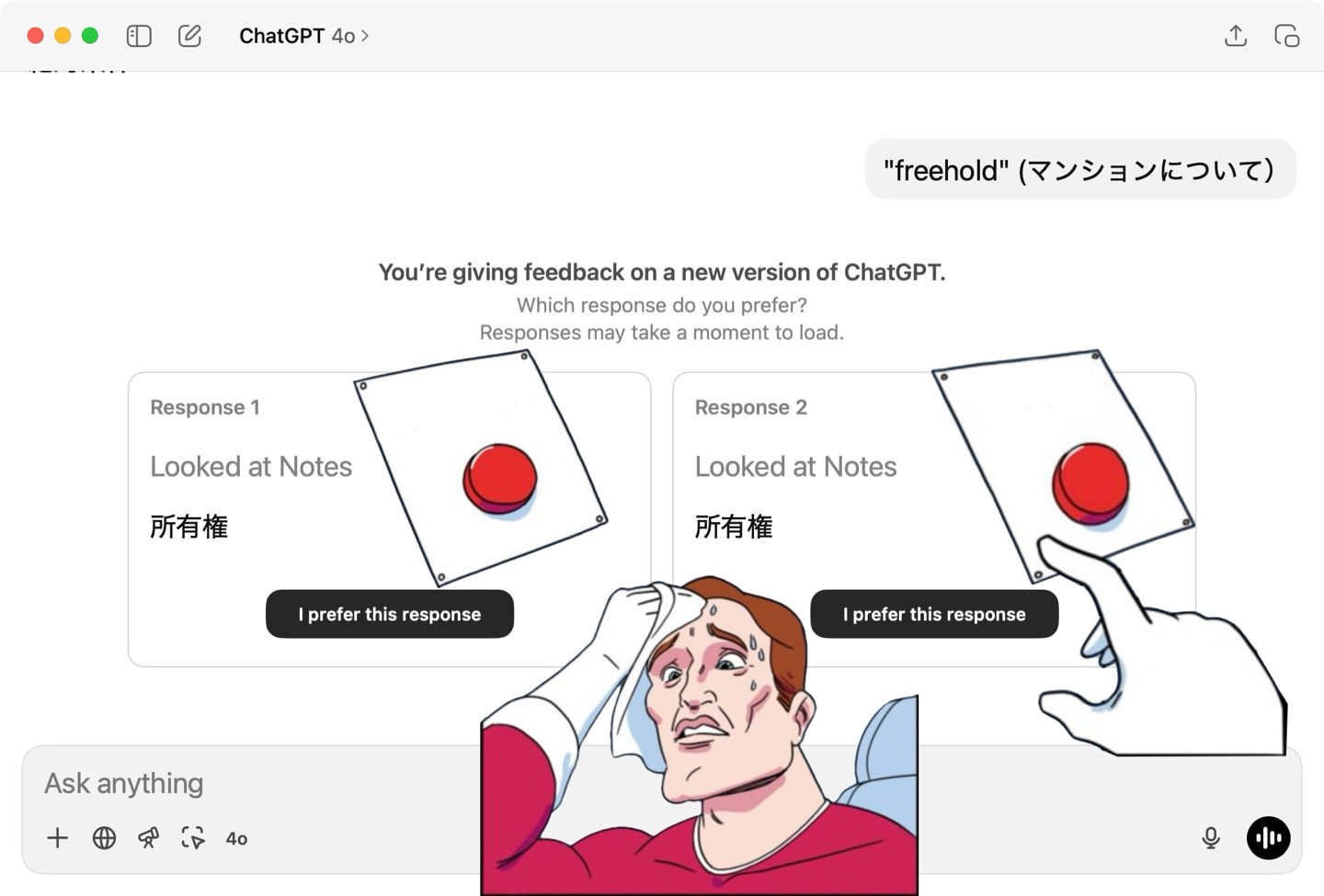Forbidden Button
I have never wanted to press a button more than I want to press this button

To any AI skeptics out there: if you take the time to use the latest tools and find them to be a net negative on your output, I completely respect that. I've been using LLMs for coding since late 2022 and until Copilot Agent landed in VS Code, I definitely think the benefit was a wash at best. Now I can see a real acceleration boost.
If you refuse to use these tools on ethical grounds or simply don't bother to keep up with them, I fear your employment prospects are likely to suffer in the short and medium term.
Like a Yakuza
Was hunkered down at a cafe in Yokohama's Chinatown earlier this week while waiting for Becky to finish a workout and looked up from my Steam Deck to notice I was simultaneously standing under the same gate in Like a Dragon: Yakuza's
Video of this episode is up on YouTube:
Coming to you LIVE from a third straight week of Japanese business hotels comes me, Justin, in his enduring quest to figure out how to exchange currency for real estate in the land of the rising fun.
[Programming note: apologies, as the audio quality at the beginning of the podcast suffered because I fucked up and left the hotel room's air conditioner on (I caught it and fixed it from the pun section onward)]
Had a few great e-mails to read through this week, but now I'm fresh out again! Before you listen, why not write in a review of this episode? podcast@searls.co and tell me about how amazing it will be before it lets you down like your best friend and/or workplace mentor and/or parent figure.
Href time:

TIL you can (re)set a sleep timer with Siri. Listening to a podcast while falling asleep and my timer paused playback before I nodded off. Clicked the AirPod stem to resume playback and said:
"Siri set a sleep timer for 15 minutes"
This actually worked! I've been getting up and tapping my device like an idiot all these years.
All the Pretty Prefectures
2025-06-13 Update: Miyazaki & Kochi & Tokushima, ✅ & ✅ & ✅!
2025-06-07 Update: Staying overnight in Nagasaki, which allows me to tighten up my rules: now only overnight stays in a prefecture count!
2025-06-06 Update: Saga, ✅!
2025-06-02 Update: Fukui, ✅!
2025-06-01 Update: Ibaraki, ✅!
2025-05-31 Update: Tochigi, ✅!
2025-05-29 Update: Fukushima, ✅!
2025-05-28 Update: Yamagata, 🥩!
2025-05-25 Update: Gunma, ✅!
2025-05-24 Update: We can check Saitama off the list.
So far, I've visited 46 of Japan's 47 prefectures.
I've been joking with my Japanese friends that I'm closing in on having visited every single prefecture for a little while now, and since I have a penchant for exaggerating, I was actually curious: how many have I actually been to?
Thankfully, because iPhone has been equipped with a GPS for so long, all my photos from our 2009 trip onward are location tagged, so I was pleased to find it was pretty easy to figure this out with Apple's Photos app.
Here are the ground rules:
- Pics or it didn't happen
- Have to stay the night in the prefecture (passing through in a car or train doesn't count)
- If I don't remember what I did or why I was there, it doesn't count
| 都道府県 | Prefecture | Visited? | 1st visit |
|---|---|---|---|
| 北海道 | Hokkaido | ❌ | |
| 青森県 | Aomori | ✅ | 2024 |
| 岩手県 | Iwate | ✅ | 2019 |
| 宮城県 | Miyagi | ✅ | 2019 |
| 秋田県 | Akita | ✅ | 2024 |
| 山形県 | Yamagata | ✅ | 2025 |
| 福島県 | Fukushima | ✅ | 2025 |
| 茨城県 | Ibaraki | ✅ | 2025 |
| 栃木県 | Tochigi | ✅ | 2025 |
| 群馬県 | Gunma | ✅ | 2025 |
| 埼玉県 | Saitama | ✅ | 2025 |
| 千葉県 | Chiba | ✅ | 2015 |
| 東京都 | Tokyo | ✅ | 2005 |
| 神奈川県 | Kanagawa | ✅ | 2005 |
| 新潟県 | Niigata | ✅ | 2024 |
| 富山県 | Toyama | ✅ | 2024 |
| 石川県 | Ishikawa | ✅ | 2023 |
| 福井県 | Fukui | ✅ | 2025 |
| 山梨県 | Yamanashi | ✅ | 2024 |
| 長野県 | Nagano | ✅ | 2009 |
| 岐阜県 | Gifu | ✅ | 2005 |
| 静岡県 | Shizuoka | ✅ | 2023 |
| 愛知県 | Aichi | ✅ | 2009 |
| 三重県 | Mie | ✅ | 2019 |
| 滋賀県 | Shiga | ✅ | 2005 |
| 京都府 | Kyoto | ✅ | 2005 |
| 大阪府 | Osaka | ✅ | 2005 |
| 兵庫県 | Hyogo | ✅ | 2005 |
| 奈良県 | Nara | ✅ | 2005 |
| 和歌山県 | Wakayama | ✅ | 2019 |
| 鳥取県 | Tottori | ✅ | 2024 |
| 島根県 | Shimane | ✅ | 2024 |
| 岡山県 | Okayama | ✅ | 2024 |
| 広島県 | Hiroshima | ✅ | 2012 |
| 山口県 | Yamaguchi | ✅ | 2019 |
| 徳島県 | Tokushima | ✅ | 2025 |
| 香川県 | Kagawa | ✅ | 2020 |
| 愛媛県 | Ehime | ✅ | 2024 |
| 高知県 | Kochi | ✅ | 2025 |
| 福岡県 | Fukuoka | ✅ | 2009 |
| 佐賀県 | Saga | ✅ | 2025 |
| 長崎県 | Nagasaki | ✅ | 2024 |
| 熊本県 | Kumamoto | ✅ | 2023 |
| 大分県 | Oita | ✅ | 2024 |
| 宮崎県 | Miyazaki | ✅ | 2025 |
| 鹿児島県 | Kagoshima | ✅ | 2023 |
| 沖縄県 | Okinawa | ✅ | 2024 |
Working through this list, I was surprised by how many places I'd visited for a day trip or passed through without so much as staying the night. (Apparently 11 years passed between my first Kobe trip and my first overnight stay?) This exercise also made it clear to me that having a mission like my 2024 Nihonkai Tour is a great way to string together multiple short visits while still retaining a strong impression of each place.
Anyway, now I've definitely got some ideas for where I ought to visit in 2025! 🌄
An elder millennial's history of the Information Age
This is a copy of the Searls of Wisdom newsletter delivered to subscribers on May 19, 2025.
Remember April? April was a month in a long line of months that left me (and, one presumes, a lot of people) asking themselves, "how did we end up here?" Well, that's what you have this weird newsletter for. And we'll get to that, I promise.
In terms of stuff I did since last time we chatted:
- Cut a couple (1, 2) good Breaking Change episodes. The content is questionable, but the audio quality has never been better
- Summarized what I consider to be the easiest-to-assess traits of strong programmers
- Started using GitHub Copilot in Agent mode, and recorded my vibe code deflowering live on YouTube
- Made Reddit angry by using a computer to generate background images for my house's rooms in HomeKit
I also started a vlog. Right now it just lives in this album in my Photos library, but initial reviews are unanimously positive!

As I start writing this, I'm sitting on an A350 bound for Tokyo, and the flight attendant just announced we won't have WiFi over the Pacific, because Viasat or whoever hasn't launched their latest satellite yet. As a writer and programmer whose greatest impediment to creative output is the risk of distracting myself on the Internet, learning that I would be forced offline for 13 hours triggered a familiar relief. My body softened. Maybe I'll actually get some sleep. If I play my cards right, I might manage to write one whole e-mail between now and when I land. [Update, 19 days later: I did not.] In any case, being kicked off the 'Net for a few hours once in a while can be restorative.
In fact, as luck would have it, one answer to the question posed at the outset ("how did we end up here?") is also, more or less, "because Internet." So today, let's talk a bit about the World Wide Web and how tangled in it we've become.
Soapy Snake
One thing I love about Japan are all the obscure Metal Gear Solid spin-offs that we never saw stateside.
If this is losing, I don't want to win
In Japan, it's common for bars to have a dice game with rules like:
- Snake eyes: free drink
- Even number: half off drink
- Odd number: double size, double price drink
I "lost" with both of these 1L whisky-fruit highballs. I sure don't feel like a loser, though.
One of the best parts of all these ridiculous side quests I accept is that I never run out of new situations to figure out. This week: how to iron my shirt and press my pants from a Japanese business hotel the day before a meeting.
Thankfully, we have YouTube
Of course, models vary between companies and I actually had to follow this less entertaining video to get figure out what to do with a standing "Twinbird" press (apparently the #1 seller in pants presses):
I'm going away on a trip for an unexpectedly long time, and you'll never guess why! (You might guess why.) Anyway, here's something to remember me by.
If you've ever been worried about whether something you cared about would work out okay, email podcast@searls.co and tell me about it so that I can share your story with a bunch of strangers on the Internet.
Video of this edition of the show is up on YouTube.
References available upon request:
Opinion | Ads linking to paywalled articles are stupid
I saw this promoted post in my Reddit feed and thought, "huh, maybe WaPo is trying to entice new readers with ads pairing gift links to articles and targeted demographics that might engage with them."
LOL, no. You click anywhere on this and you instantly get hit with a paywall.
Who is this for? Current subscribers that don't read the Washington Post? People who planned to subscribe and forgot?
Absolute idiocy.
This one's tough, Sam
One of my favorite things about OpenAI is when they A/B test ChatGPT responses and the computer arrives at two identical responses, but still insist you tell them which answer was better.
I'm feeling the response on the right, personally.









